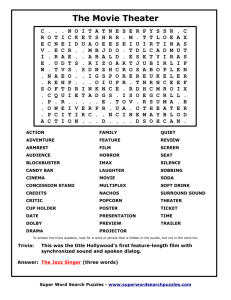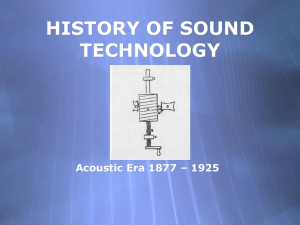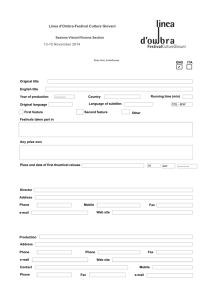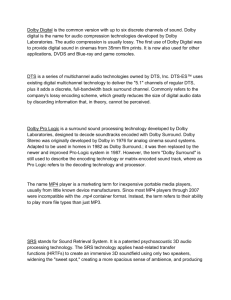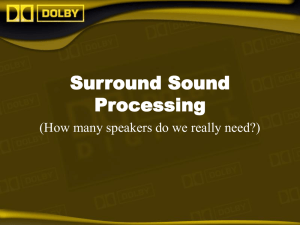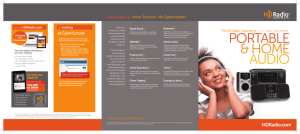Frequently asked QUESTIONS about DOLBY DIGITAL
advertisement
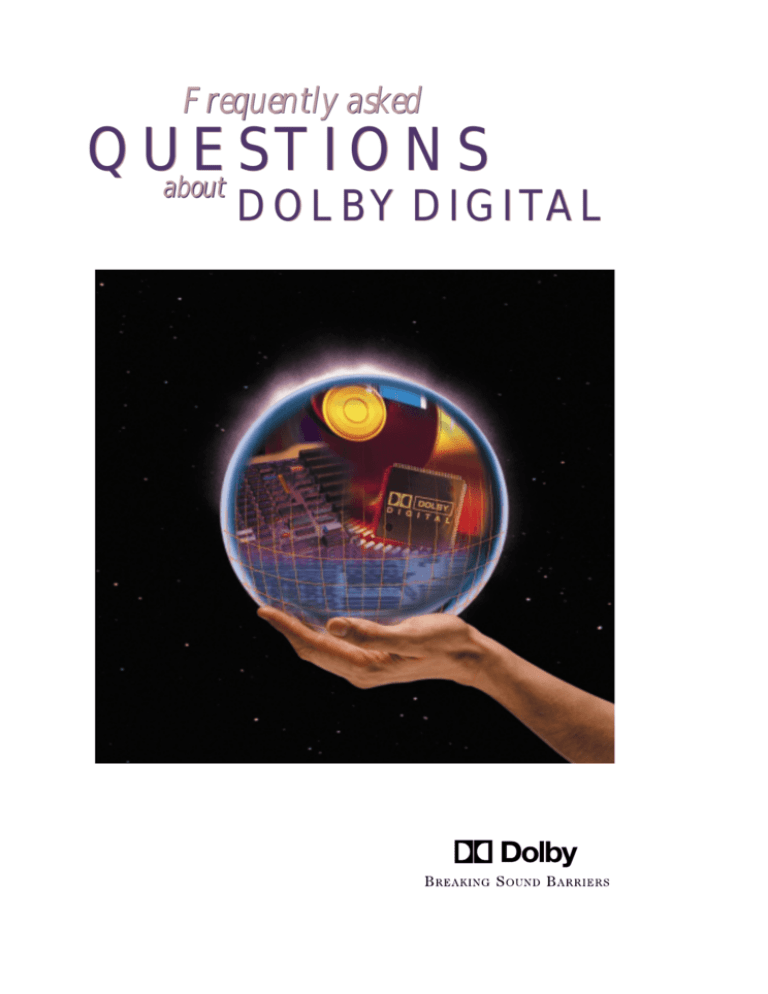
Frequently asked QUESTIONS about DOLBY DIGITAL Table of Contents 1. What is Dolby Digital? ............................................................................................................................................ 1 2. What program sources deliver Dolby Digital audio? ......................................................................................... 1 3. Can I hear Dolby Digital programs over a regular stereo or Dolby Surround Pro Logic system? .............. 1 4. What is “5.1-channel” Dolby Digital? .................................................................................................................... 1 5. How does 5.1-channel Dolby Digital differ from Dolby Surround? .................................................................. 1 6. Does 5.1-channel Dolby Digital make Dolby Surround obsolete? .................................................................... 2 7. How can I hear a 5.1-channel Dolby Digital soundtrack over a regular stereo or Dolby Surround Pro Logic system? .................................................................................... 2 8. Do all Dolby Digital programs provide 5.1 channels? ....................................................................................... 2 9. Do all DVD-Video discs have Dolby Digital soundtracks? ................................................................................ 2 10. How can I determine the soundtrack’s format? ................................................................................................. 2 11. Do all program sources with Dolby Digital decoding provide 5.1-channel sound? ...................................... 3 12. How do I convert my current Dolby Surround Pro Logic system to 5.1-channel playback? ....................... 3 13. Will I still be able to play Dolby Surround program material? ......................................................................... 4 14. Can I use my current speakers? ............................................................................................................................ 4 15. What kind of speakers should I get for an all-new Dolby Digital system? ...................................................... 4 16. Should I use bipolar, dipolar, or tripolar surround speakers? ......................................................................... 4 17. My new Dolby Digital decoder has a multi-pin “DB-25” connector, but my audio components only have phono connectors. What do I do? ...................................................... 5 18. My DVD player has two digital outputs, one optical and one coaxial, and my Dolby Digital decoder has both kinds of inputs. Which should I use? ............................................ 5 19. Why does my Dolby Digital decoder provide time delays? .............................................................................. 5 20. How to I set the surround time delays? ............................................................................................................... 5 21. How do I set the center channel time delay? ..................................................................................................... 5 22. What is the “Midnight Mode” on my new Dolby Digital A/V receiver? ........................................................... 6 23 I’m tired of having to adjust the volume every time the program changes or I switch sources or TV channels. Can Dolby Digital help? .......................................................................... 6 24. What equipment do I need to play Dolby Digital Laserdiscs? ......................................................................... 6 25. What equipment do I need to receive satellite broadcasts with 5.1-channel Dolby Digital sound? .......... 7 26. How can I receive high-definition (HD) satellite TV transmissions with Dolby Digital sound? .................. 7 27. Can I use my Dolby Digital home theater system for the new digital TV broadcasts? ................................ 7 28. How can I receive digital cable programs with Dolby Digital sound? ............................................................. 7 29. Can I purchase DVD-Video discs with Dolby Digital soundtracks in Europe? ............................................... 7 30. I’m thinking about getting a PC with a DVD-ROM drive. Will it give me 5.1-channel Dolby Digital? .......... 8 31. I’ve heard about surround-sound systems that use only two speakers. Do they really work? .................. 8 32. Is it possible to get surround sound over headphones? .................................................................................. 9 33. Does Dolby plan to introduce higher data-rate versions of Dolby Digital? ................................................... 9 34. I’ve heard that Dolby Digital isn’t as good as some competing systems. Is this true? ................................ 9 35. Will Dolby Laboratories provide 5.1-channel music CDs? .............................................................................. 10 36. Can I play the new DVD-Audio discs on my DVD-Video player or my computer’s DVD-ROM drive? ....... 10 How Dolby Digital Works ............................................................................................................................................. 11 Dolby Digital vs. Dolby Surround comparison chart ............................................................................................... 12 Dolby Surround/Dolby Digital delivery paths chart ................................................................................................ 13 Frequently Asked Questions about Dolby Digital D olby Digital multichannel audio is the next step forward in sonic realism and listener involvement. It has already changed the way you experience your favorite films in movie theatres, and is now doing the same for video programming at home. 1. What is Dolby Digital? Dolby Digital is an advanced form of digital audio coding that makes it possible to store and transmit high-quality digital sound far more efficiently than was previously possible. First used in movie theatres in 1992, it is the result of decades of experience by Dolby Laboratories in developing signal processing systems that exploit the characteristics of human hearing. 2. What program sources deliver Dolby Digital audio? Dolby Digital audio is available from laser discs, DVD-Video discs, DVD-ROM discs for computers, digital cable systems, direct broadcast satellite (DBS) systems, and digital broadcast TV (DTV). Discs are usually marked with the logo. 3. Can I hear Dolby Digital programs over a regular stereo or Dolby Surround Pro Logic system? Yes, you can use most of the new Dolby Digital program sources with your current playback system, because they have Dolby Digital decoders built in to provide conventional analog stereo outputs. However, to experience the thrilling 5.1-channel surround sound used on many Dolby Digital programs, you typically need a separate unit, such as an A/V receiver, that incorporates a 5.1channel Dolby Digital decoder. 4. What is “5.1-channel” Dolby Digital? At the option of their producers, Dolby Digital programs can deliver surround sound with five discrete full-range channels— left, center, right, left surround, and right surround—plus a sixth channel for those powerful lowfrequency effects (LFE) that are felt more than heard in movie theatres. As it covers only about one-tenth the audible bandwidth of the other channels, LFE is referred to as a “.1” channel. Figure 1 illustrates a typical 5.1 Left playback system; see question 14 on page 4 for further information on speakers, including subwoofers. 5. How does 5.1-channel Dolby Digital differ from Dolby Surround? 5.1-channel Dolby Digital provides two surround channels to Dolby Surround’s one for more precise localization of sounds and a more convincing, realistic ambience. Also, the surround channels cover the entire audible range (20–20,000 Hz), whereas the range of Dolby Surround’s single surround channel is limited to 7,000 Hz. This further heightens realism and gives sound mixers more creative freedom. In addition, Dolby Digital’s multiple discrete channels enable more sharply delineated spatial effects, and its “.1” LFE track makes it possible to reproduce low bass effects with stunning impact (twice as loud as the other channels). On page 12 you will find a chart comparing Dolby Surround and Dolby Digital, and on page 13 a diagram of how each works at the mixing, mastering, and playback stages. Right LFE Center Left surround Dolby Digital program source (DVD player, DTV receiver, digital cable box, etc.) Right surround Audio electronics with Dolby Digital decoding Figure 1: Dolby Digital can deliver up to 5.1 discrete sound channels for the ultimate in surround sound. 1 6. Does 5.1-channel Dolby Digital make Dolby Surround obsolete? No, Dolby Surround will be with us for as long as stereo is with us. This is why all Dolby Digital decoder units also incorporate a digitally implemented Dolby Surround Pro Logic decoder. Dolby Surround encodes four sound channels (left, center, right, surround) onto the two tracks of any conventional stereo program source, either analog or digital. Dolby Digital soundtracks, on the other hand, can be carried only by digital formats such as DVD and DTV. Dolby Surround-encoded programs can be played back in mono, stereo, or with a Dolby Surround Pro Logic decoder that recovers the four original channels. Dolby Surround sources include regularly scheduled TV programs (currently over 100 in the U.S.), plus sports and special events; a growing number of video games, CD-ROMs, and music CDs; and broadcasts, tapes, and video discs of thousands of movies. 7. Can I hear 5.1-channel Dolby Digital programs over a regular stereo or Dolby Surround Pro Logic system? Yes. All Dolby Digital decoders, whether 5.1-channel or two-channel, have a unique feature called “downmixing” that assures full compatibility with any playback system. On 5.1channel programs, the decoders can create several types of mixes “on the fly.” These include a twochannel, Dolby Surroundencoded mix for playback over a home theater system with Dolby Surround Pro Logic decoding; a two-channel stereo mix for regular stereo and headphone playback; or a mono mix for playback over a mono TV set (see Figure 2). This makes it possible for producers of 5.1-channel programs to provide only the one 5.1-channel mix on the disc or 2 9. Do all DVD-Video discs have Dolby Digital soundtracks? Figure 2: Dolby Digital decoders automatically configure the signal to the particular playback circumstances. other source. The decoder in the playback system does the rest, automatically conforming the signal to the particular playback circumstances. Note: downmixing is not used for laser discs because they contain three different soundtracks: stereo PCM for a conventional stereo or Dolby Surround mix; one FM track for a mono mix; and one FM track for a 5.1-channel Dolby Digital mix. Frequently these mixes are prepared at different times, even by different mixers, so they can sound quite different from each other. 8. Do all Dolby Digital programs provide 5.1 channels? No, Dolby Digital soundtracks can provide anything from mono to full 5.1-channel surround sound. DVD-Video discs of movies can even carry multiple versions of the soundtrack that differ in the number of channels. A disc might contain a 5.1channel sound mix with the dialogue in one language, a Dolby Surround-encoded two-channel mix in another language, and a mono track with the director’s comments or other supplementary information. The default soundtrack will vary from disc to disc, so always check the DVD disc’s Language menu for the choices offered. Mono Stereo Discs distributed in countries that use the NTSC broadcast TV standard (such as the U.S.) must provide at least one soundtrack in either of two formats: Dolby Digital or PCM (the format used on CDs). In countries using the PAL TV standard (including much of Europe), the discs must include at least one soundtrack in any one of three formats: Dolby Digital, PCM, or MPEG. As a result of these requirements and the options they permit, not all discs have Dolby Digital soundtracks. Dolby Digital, however, is the only universal multichannel standard, and every DVD player sold worldwide incorporates Dolby Digital decoding. Therefore the vast majority of discs do include at least one Dolby Digital soundtrack. 10. How can I determine the soundtrack’s format? The logo on a DVDVideo Disc or other program source indicates that it has one or more Dolby Digital-encoded soundtracks, but it does not indicate the number of channels. To help identify the latter, Dolby Figure 3: Many DVD-Video discs and other Dolby Digital sources display symbols identifying the soundtrack’s channel format. Dolby Surround 5.1-channel Figure 4: Some Dolby Digital decoders feature a display activated by the format data on Dolby Digital soundtracks. Laboratories is encouraging the use on program packaging of the channel format symbols shown in Figure 3. In addition, to prevent confusion at playback, data identifying the original production format of a program’s soundtrack is incorporated right into the Dolby Digital data stream. Some Dolby Digital decoder units use this data to display on the control panel the type of soundtrack you’re listening to (see Figure 4). described in question 12, for 5.1channel sound. However, you will not be able to use the internal Dolby Digital decoder for other program sources, and these players don’t usually offer the full range of options provided by external Dolby Digital decoder units. On the other hand, they are an inexpensive way to upgrade to 5.1-channel Dolby Digital initially, and provide a digital output so that you can later bypass the built-in decoder and use an external one. 11. Do all program sources with Dolby Digital decoding provide 5.1-channel sound? 12. How do I convert my current Dolby Surround Pro Logic system for 5.1channel playback? As with Dolby Digital program material, the phrase “Dolby Digital” on a component such as a DVD player means only that it incorporates Dolby Digital decoding; it does not indicate the number of channels. Many program sources, including DVD players and digital cable set-top boxes, provide a built-in two-channel Dolby Digital decoder with analog stereo outputs (see question 7). For 5.1channel playback, most units have a separate digital output that provides the undecoded Dolby Digital signal (data stream) for connection to an external unit, such as an A/V receiver, that has its own 5.1-channel Dolby Digital decoder. See Figure 5. Some DVD players do pro- If your current system consists of separate audio components, you will need a 5.1channel Dolby Digital decoder and a six-channel preamplifier (available separately or combined in one convenient unit). The preamplifier’s outputs will plug into your existing power amplifiers (see Figure 6-a). If you have an older, integrated A/V receiver with Dolby Surround Pro Logic that does not provide external inputs to its built-in amplifiers, you have two choices. You can replace it with a new receiver incorporating a 5.1-channel Dolby Digital decoder, or add an external Dolby Digital decoder unit that includes center, left surround, and right surround amplifiers to use in place of those in your receiver (which will continue to power the left and right front speakers). This same solution also works for upgrading a conventional stereo system (see Figure 6-b). Figure 6-a. Figure 6-b. Figure 6-c. Figure 5: Most DVD-Video players provide stereo (two-channel) analog audio outputs (left), plus at least one Dolby Digital output (right). The unit above has two different kinds of Dolby Digital outputs, co-ax and optical; see question 18 on page 4 for advice on which to use when you have the choice. vide a built-in Dolby Digital 5.1channel decoder with multiple analog outputs that can be connected directly to a “Dolby Digital-ready” receiver, as Figure 6-d. Figure 6. Converting to 5.1-channel playback. 3 If you have a newer “Dolby Digital-ready” A/V receiver with multichannel inputs for an external Dolby Digital decoder, you can add a decoder anytime, using the receiver’s built-in Dolby Surround Pro Logic decoder in the meantime for satisfying home theater sound. You can also connect the multichannel outputs of a DVD-Video player that has built-in 5.1-channel Dolby Digital decoding to this kind of receiver. An external decoder is still needed, however, for other Dolby Digital program sources (see Figures 6-c and 6-d, and question 11). Note: be sure that the new decoder unit has a sufficient number of digital inputs to accommodate all the Dolby Digital program sources you expect to use (DVD-Video player, digital cable set-top box, digital TV receiver, etc.). Also, if you plan to play Dolby Digital laser discs, be sure that the unit also includes the necessary RF demodulator. (Only laser discs require this feature; see question 24.) 13. Will I still be able to play Dolby Surround program material? Yes, all Dolby Digital decoders include Dolby Surround Pro Logic decoding, so you can continue to enjoy Dolby Surround-encoded programs after converting your system. the surround channels’ low bass, and so continue to use the limited-bandwidth surround speakers you got for Dolby Surround Pro Logic playback. Or you could use small satellite speakers for the five main channels and route all bass to a subwoofer. You could even go so far as to add a subwoofer to each main channel. For information on speaker placement, visit www.dolby.com/ ht/sound/sound2.html. This information can also be found on page 6 of the booklet “Dolby Surround: The Sound of Home Theater,” published by Dolby Laboratories. 15. What kind of speakers should I get for an all-new Dolby Digital system? The ideal Dolby Digital playback system would use identical full-range speakers for the left, center, right, and each surround channel. If this is impractical, be sure that the overall tonal characteristic, or timbre, of all the speakers is similar. This is equally important for both Dolby Surround Pro Logic and Dolby Digital playback. 4 16. Should I use bipolar, dipolar, or tripolar surround speakers? Surround speaker placement, room acoustics, and personal preference are as important as the speakers’ radiating characteristic. These factors vary greatly, so Dolby Laboratories cannot recommend a particular speaker for home theater use. Bipolar, dipolar, and tripolar surround speakers use speaker drivers aimed towards the front and back of the room to achieve a diffuse soundfield like that created by the multiple surround speakers used in movie theatres. Your room’s acoustics will effect these designs more than conventional direct-radiating speakers, which, when placed properly, can also make effective surround speakers. Unbalanced Pin 1 2 3 4 5 6 7, 8 9, 10 11 12 13 Assignment Left positive Center positive Right positive Subwoofer positive (or L sub) Left surround positive Right surround positive Reserved (optional R sub) Shield drains Remote trigger C Reserved Remote trigger A (power) Pin 14 15 16 17 18 19 20, 21 22 23 24 25 Assignment Left ground Center ground Right ground Subwoofer ground Left surround ground Right surround ground Reserved Shield drain Remote trigger C ground Logic ground Remote trigger A ground Balanced Pin 1 2 3 4 5 6 7, 8 9, 10 11 12 13 Assignment Left positive Center positive Right positive Subwoofer positive Left surround positive Right surround positive Reserved Shield drains Remote trigger C Reserved Remote trigger A (power) Pin 14 15 16 17 18 19 20, 21 22 23 24 25 Assignment Left negative Center negative Right negative Subwoofer negative Left surround negative Right surround negative Reserved Shield drain Remote trigger C ground Logic ground Remote trigger A ground 14. Can I use my current speakers? Yes, you can use your current speakers, because the configuration for Dolby Digital’s five main channels is essentially the same as that for Dolby Surround Pro Logic (refer to Figure 1 on page 1). A unique feature called Bass Management lets you route low bass sounds to those speakers in your system that are best able to reproduce them. For example, you might wish to route the LFE signals to the front left and right speakers, if they have full bass capabilities, or to a separate subwoofer. You can also redirect Most speaker manufacturers offer timbre-matched home theater speakers. Many also offer systems combining matched compact speakers for the five main channels with one or more separate subwoofers for the nondirectional bass; such a “satellite” system can prove an effective, space-saving solution. Figure 7: Pin configuration for DB-25 connectors. 17. My new Dolby Digital decoder has a 25-pin Dsub connector, but my audio components only have phono connectors. What do I do? The DB-25 interface was developed by Lucasfilm THX to save space on the rear panels of home theater products. If your components use a mix of connectors, cables with a DB-25 (25-pin) connector on one end and multiple phono connectors on the other are available from home theater equipment retailers. If you wish to make your own adapter, see Figure 7 for the DB-25 pin configuration. 18. My DVD player has two digital outputs, one optical and one coaxial, and my Dolby Digital decoder has both kinds of inputs. Which should I use? Under most conditions, optical and coaxial digital connections work equally well. Under some rare circumstances, however, coaxial cables, particularly very long ones, can pick up radio frequency (RF) interference generated by household appliances, or nearby hightension power lines or broadcast towers. Coaxial is less expensive, so is a good place to start. Note: some DVD players and Dolby Digital decoders have either a coaxial or an optical connector. Be sure that the units you purchase both use the same type. Figure 8: Use dimensions A and B to calculate surround delay using either chart to right; setting delay for one mode will provide correct delay for the other. 19. Why does my Dolby Digital decoder provide time delays? Because the surround speakers in a home theater system are usually closer to viewers than the front speakers, both Dolby Digital and Dolby Surround Pro Logic playback require a splitsecond electronic delay of the surround channels to optimize arrival time relationships. In the case of Dolby Digital, the delay ensures that the listener hears sound from the surround and front speakers simultaneously. For Dolby Surround Pro Logic, which has less inherent channel separation than Dolby Digital, a slightly longer (by 15 milliseconds) delay ensures that sound from the surrounds arrives just after sound from the front. This delay reduces the audibility of frontchannel sounds that might leak into the surround speakers. Some Dolby Digital decoder units also provide an adjustable center-channel delay to ensure that the viewer hears sound from all three front speakers simultaneously. Because the relationship between the two delays is fixed, you only need to set the delay in one mode. The decoder will automatically provide the appropriate delay whenever you switch to the other mode. To establish the proper surround delays for your system, you need to know the distances between your viewing position and a front speaker (A) and a surround speaker (B) as shown in Figure 8. Then, using Figure 9 (Dolby Pro Logic mode) or 10 (Dolby Digital mode), find the distance to the surround speaker on the graph’s vertical axis, and the distance to the front speaker on the horizontal axis. Lines drawn from these points will intersect on the graph at the recommended delay setting. Many decoders simplify this process by allowing you to simply enter these distances into the system for automatic adjustment. 21. How do I set the center channel time delay? The time delays in your Dolby Digital decoder are preset to provide good results in most home theater installations. If you wish to fine-tune the adjustments, consult the decoder’s instruction manual. Most units allow you to adjust the surround delay in either the Dolby Digital or Dolby Surround Pro Logic mode. Adjusting the center channel delay has a subtle effect, so under normal circumstances there is no need to worry about it. If you nevertheless wish to set it very precisely, read on. You need no center delay (set it at “0”) if your seating area is small with a few viewers at any time, and if you can place the three front speakers equidistant from it as shown in Figure 11-a. If the center speaker must be placed more in line with the left and right speakers, as shown in figure 11-b, thereby bringing it closer to the viewers than the left Figure 9: Calculating surround delay with decoder set to Dolby Surround Pro Logic mode. Figure 10: Calculating surround delay with decoder set to Dolby Digital mode. 20. How do I set the surround time delays? 5 L C R L = C = R: Center delay = 0. Figure 11-a. L R L = R > C, small seating area: Center delay (ms) = L or R – C (ft.). L 22. What is the “Midnight Mode” on my new Dolby Digital A/V receiver? Dolby Digital soundtracks can have a very wide dynamic range between soft and loud sounds. At a full playback level, this can be thrilling, providing a truly theatrical experience, particularly for movies. Late at night, however, the loud sound effects found on some movie soundtracks could disturb your family or neighbors. But if you turn down the volume to “keep the peace,” the dialogue will be hard to hear, and subtle low-level effects may get lost altogether. What you’d really like to do is turn down the volume on just the loud effects, turn up the volume on quiet sounds, and keep the dialogue at the same level. This is exactly what Dolby Digital’s Dynamic Range Control feature does. To help explain its function, manufacturers of Dolby Digital C R L = R > C, wide seating area: Center delay = 0. Figure 11-b. Figure 11: Setting center channel time delay. and right speakers, add 1 ms of delay for each foot it is closer. For example, if dimension C in Figure 11-b is one foot less than L or R, set the time delay to 1 ms. If your seating area is wide, with several viewers in a row as in a movie theatre, it’s best to place the left, right, and center speakers all in line, as shown in Figure 11-c, and use no center time delay. Finally, if it is necessary to place the center speaker further back than the left and right speakers (not illustrated), select a –1 ms delay (for a one foot difference) or –2 ms delay (for two feet), if these options are provided. If they are not provided, use “0” delay. 6 C dialogue remains constant. It does not alter the dynamic range, only the overall playback level, based on data about the average soundtrack loudness that is coded into the program signal (see Figures 13 and 14). Figure 11-c. decoders have come up with names like “Midnight Mode” for this feature (see Figure 12). Figure 13: The average level of conventional program sources, and even individual programs, varies greatly. Figure 14: Dolby Digital’s Dialog Normalization maintains a consistent playback level for all programs keyed to their dialogue level. Figure 12: With Dynamic Range Control on, the full dynamic range (A) of the program is reduced (B), as predermined by the producers. The amount of compression is not arbitrary, but is decided in advance by the soundtrack’s producers, and coded right onto the soundtrack. Some Dolby Digital decoders let you select various amounts of the available compression (e.g., 50%, 75%, 100%), while others provide only 100% when the compression mode is selected. 23. I’m tired of having to adjust the volume every time the program changes or I switch sources or TV channels. Can Dolby Digital help? Yes. Conventional program sources often force you to readjust the volume when you change channels or play a different video. With Dolby Digital program sources, on the other hand, a feature called Dialogue Normalization lets you set playback volume and forget it. Dialogue Normalization automatically adjusts the volume when you change Dolby Digital programs so that the level of the With Dialog Normalization, you can “channel surf” when watching digital TV without having to adjust the volume each time you change channels. And you can play an evening’s worth of DVD-Video discs without ever touching the volume control. 24. What equipment do I need to play Dolby Digital laser discs? Dolby Digital laser disc players do not have a built-in Dolby Digital decoder; they output the Dolby Digital data stream from laser discs on a radio-frequency (RF) carrier that requires demodulation prior to Dolby Digital decoding. If you wish to play the Dolby Digital soundtrack on laser discs, therefore, be sure that the disc player has a “Dolby AC-3 RF” output, and that your Dolby Digital decoder unit includes an RF demodulator specifically for laser disc use. Not all decoder units provide the demodulator, because no other Dolby Digital program source, including DVD, requires it. If you have an older laser disc player and don’t want to decode the Dolby Digital tracks on newer discs, they will play perfectly well on your older player. On laser discs, the Dolby Digital track is encoded on what used to be the right FM analog track, leaving the standard PCM digital stereo tracks intact for conventional stereo and Dolby Surround Pro Logic playback. The left FM analog track may contain a mono version of the soundtrack, commentary, or other material (see Figure 15). One final note: laser discs with 5.1-channel Dolby Digital soundtracks were originally identified as Dolby Surround AC-3, “AC-3” being the technical term for the digital audio Standard stereo audio, usually Dolby Surround-encoded, is broadcast simultaneously, so you need a new satellite receiver only if you wish to receive the Dolby Digital soundtrack. 26. How can I receive high-definition (HD) satellite TV transmissions with Dolby Digital sound? To receive high-definition programming transmitted via satellite, you will need an HD satellite receiver, and possibly a new, larger dish. Most receivers are equipped like most DVDVideo players, that is, with a built-in, two-channel Dolby Digital decoder with analog stereo outputs, and a Dolby Digital output for 5.1-channel sound with an external 5.1-channel Dolby Digital decoder unit. 27. Can my Dolby Digital home theater system decode the new digital TV broadcasts? Figure 15: Soundtrack configurations of conventional laser discs (top) and those with Dolby Digital audio (bottom). coding upon which Dolby Digital is based. Today the simpler term “Dolby Digital” is used instead to identify laser discs, like other formats, that have Dolby Digital soundtracks. 25. What equipment do I need to receive satellite broadcasts with 5.1channel Dolby Digital sound? To receive the 5.1-channel soundtrack on broadcasts such as Dolby Digital-encoded theatrical films, you’ll need a satellite receiver that provides a Dolby Digital output (the generic “Digital” output on conventional satellite receivers does not handle Dolby Digital signals). As with other Dolby Digital components, you connect the receiver’s Dolby Digital coaxial or optical output to a digital input on your Dolby Digital decoder unit. Yes, it will. Whether highdefinition (HD) or standarddefinition (SD), all digital television (DTV) broadcasts in the U.S., Canada, and other countries that have adopted the ATSC television standard (www.atsc.org) are transmitted with Dolby Digital. Dolby Digital audio is also an option for broadcasts in areas such as Europe using the DVB digital TV standard. All such broadcasts are compatible with existing Dolby Digital decoders. Like other Dolby Digital program material, the audio format of DTV broadcasts varies from mono to full 5.1-channel surround sound. Because most TV facilities have to gear up for multichannel audio production and distribution, many DTV programs are being broadcast initially in two-channel Dolby Digital (often Dolby Surroundencoded for four-channel playback with Dolby Surround Pro Logic decoding). DTV sets and tuners also vary with respect to the number of audio channels they provide. Some have built-in two-channel Dolby Digital decoders, while others have 5.1-channel Dolby Digital decoders for connection to a Dolby Digital-ready A/V receiver (see question 12). Others include not only Dolby Digital decoding but also amplifiers and speakers. Most DTV receivers have a separate digital output that provides the undecoded Dolby Digital signal for connection to your A/V receiver or other unit with 5.1-channel Dolby Digital decoding. As a result, you can add a DTV receiver to your Dolby Digital home theater system at any time, without fear of obsolescence or costly equipment duplication. 28. How can I receive digital cable programs with Dolby Digital sound? Digital cable television systems can provide you with another source of programming for Dolby Digital playback. The number of channels with Dolby Digital cable transmissions varies as with DTV broadcasts and other Dolby Digital program sources. All digital cable set-top boxes incorporate a two-channel Dolby Digital decoder with stereo analog outputs for compatibility with conventional stereo and home theater systems, while some units also provide a digital output for multichannel playback via an A/V receiver or other unit with a 5.1-channel Dolby Digital decoder. 29. Can I purchase DVDVideo discs with Dolby Digital soundtracks in Europe? Yes, Dolby Digital audio is used on DVD-Video discs throughout the world (see question 9). A word of caution, though: while the audio and video technical standards are the same for DVD-Video worldwide, discs purchased in one part of the world may not play at all in another part of the world due to “regional coding.” 7 Regional coding was developed at the behest of the film industry, which often releases movies on video in North America before they’ve even reached movie theaters in other parts of the world. Discs released in a market like North America (Region 1) can be coded to play only on players manufactured for that market. Take a Region 1coded disc to another part of the world, and it won’t work in the players manufactured for that market. Some discs, on the other hand, are coded as Region 0, meaning they will play on all DVD players in all regions. Check the packaging to find out if the disc has any regional limitations. 30. I’m thinking about getting a PC with a DVDROM drive. Will it give me 5.1-channel Dolby Digital? That depends on the computer’s configuration and its DVD/ audio card, so check the specifications carefully to be sure you get the audio capability you want. Most PCs can be connected to external playback equipment ranging from amplified stereo speakers to a full 5.1-channel playback system. The latter include not only full home theater systems, but compact, multichannel PC speaker systems incorporating amplifiers and Dolby Digital and/or Dolby Surround Pro Logic decoding. PCs bundled with stereo amplifiers and speakers may have a built-in two-channel Dolby Digital decoder for the DVD-ROM player that will downmix 5.1-channel soundtracks. Audio outputs possible on PCs include analog power amplifier outputs, line-level outputs for external amplifiers, headphone jacks, and RF carriers. They may also provide conventional PCM digital audio outputs, and/or outputs that provide the undecoded Dolby Digital data stream via S/PDIF (IEC 1937), USB, IEEE 1394, LAN, wireless link, or other format connections. PCs that offer a S/ PDIF output that passes through the Dolby Digital stream, or 8 provide multichannel analog outputs, may be identified with the logo on the system itself. 31. I’ve heard about surround-sound systems that use only two speakers. Do they really work? center image, while the surround signals are processed by a “virtualizer” circuit and mixed in with the main left and right channel signals. The virtualizer processor adds cues to the surround signals based on how we identify a sound’s directionality, thereby creating virtual surround images from just two speakers. Unlike a multispeaker home theater system, the center and surround effects are affected only by the listener’s position relative to the two speakers, and not by room acoustics (see Figures 16 and 17). Dolby offers its own virtualizer technique, and also tests and approves other virtualizers for use in combina- Thanks to the increasing power and dropping cost of signal-processing chips, sound that appears to come from around the listener is now possible with just two speakers. These audio processing systems, often referred to as “virtual surround,” require that the listener be positioned in a specific “sweet spot” in front of the two speakers. As a result, they cannot substitute for multiple speakers in Dolby Surround or home theater Dolby Digital program applications. But for PCs, where a single user is seated directly in front of the monitor, they can provide a costeffective alternative to a full, multispeaker surround setup. There are two fundamental approaches to “virtual surround.” Some systems take any stereo program source and create what might be called a “pseudo-surround” effect. The results are inconsistent, however, Figure 21: Signals from a Dolby Surround Pro Logic or Dolby Digital and can create effects decoder are processed by a “virtualizer” circuit to produce the effect of surround sound with two speakers. not at all intended by tion with Dolby Surround Pro the program producers. The Logic and Dolby Digital decoding other approach has been to create Virtual Dolby Surround developed by Dolby Laboratories and Virtual Dolby Digital. to reproduce the actual surround Approved technologies include information recorded on 3D Phonic, Virtual Sonic, VMAx, multichannel Dolby Surround and A3D, Qsurround, N-2-2 DVS, Dolby Digital program material, TruSurround, Sensaura, RSX, and for a more accurate and consistIncredible 3D Surround. ent listening experience. Products with Virtual Dolby Called Virtual Dolby Surround and/or Virtual Dolby Surround and Virtual Dolby Digital include DVD players, PC/ Digital, these processes start by DVD packages, television sets, decoding, respectively, the and multimedia speaker systems. original four or 5.1 channels of the program material. The center channel is then divided equally between the left and right speakers to create a phantom 34. I’ve heard that Dolby Digital isn’t as good as some competing systems. Is this true? Figure 17: While five speakers are necessary for home theater (left), Virtual Dolby Surround and Virtual Dolby Digital (right) provide convingincing surround sound for an individual listener from only two speakers. 32. Is it possible to get surround sound over headphones? Yes, it is now possible to achieve convincing surround sound over conventional stereo headphones from both 5.1channel Dolby Digital and fourchannel Dolby Surround-encoded programs, thanks to a new development called Dolby Headphone (see Figure 18). stereo headphones, the sum of the direct and reflected sounds from each virtual speaker in the virtual room. With conventional headphone listening, by contrast, the sound is fed directly to your eardrums without these spatial cues. The result is an unnaturally flat image, with left and right sounds directly beside you, and center sounds within your head. This “in-head” effect is not only unrealistic, but can also be tiring. Dolby Headphone works with both stereo and multichannel program sources, and can be included in just about any product with a headphone jack, including set-top boxes, VCRs, DVD players, conventional and digital TV receivers, PCs and laptops, and A/V surround decoders and receivers. Figure 18: Dolby Headphone enables convincing surround sound over conventional stereo headphones by electronically imparting the unique sonic signatures of speakers in a listening room. 33. Does Dolby plan to introduce higher datarate versions of Dolby Digital? Dolby Headphone is a signal processor that recreates the sound of a real five-speaker surround system playing multichannel material in an actual listening room. It works by electronically imparting to each audio channel—two on stereo programs and up to five on surround programs—the unique sonic signature of a corresponding speaker properly placed in a carefully-defined acoustic environment. The processor combines the signatures into two composite channels that deliver to your ears, via conventional While all Dolby Digital decoders are capable of handling data rates as high as 640 kb/s, the 448 kb/s rate used on DVDs (the maximum allowable) provides sound quality that critical listening tests have consistently confirmed as on a par with original master tapes. It would require the introduction of a new delivery format before the option to use more than 448 kb/s would even be considered. No, it’s not. In fact, most such statements are based on the assumption that “more is better,” and not on proper listening tests. To understand what’s going on with respect to Dolby Digital and competing systems, you first need to know something about “perceptual” digital audio coding. Conventional digital audio, like that used on CDs, encodes the audio using 16-bit PCM (pulse code modulation), which expresses the value of the original analog waveform in each channel to one of 65,536 possible levels, 44,100 times per second. This already takes up a lot of storage and transmission space for plain stereo, so providing multiple channels of PCM for surround sound has been impractical, particularly for media that also has to carry data-hungry digital video. As a result, Dolby Digital and other coding systems (such as MPEG, DTS, and ATRAC) have been developed to save space by transmitting only the data that’s necessary to portray the original sound based on what we can actually hear, as opposed to delivering the original PCM data bit-for-bit. As a result, these are sometimes known as “perceptual” or “lossy” coding systems. A complex coding scheme, or algorithm, processes the audio signal based on the principles of psychoacoustics, the science of how we perceive sound. The coder takes advantage of noise and frequency masking to allow capturing the audio with just enough precision to make sure it sounds the same as the original. The more powerful the algorithm, the more precisely the encoder can shave bits without affecting the perceived sound quality. This is why some coder technologies such as Dolby Digital can sound just as good as others like DTS which use from two to four times as much data. Dolby Digital’s algorithm, technically known as Dolby AC-3, is based upon Dolby Laboratories’ 9 decades of research into how we perceive sound, and delivers 5.1 channels of audio with up to 24-bit precision at an even higher (48 kHz) sample rate than conventional CDs. As a result, Dolby Digital achieves very high sound quality at the low data rates necessary for uncompromised picture quality on such formats as DVD-Video discs and DTV digital television broadcasts. 35. Will Dolby provide 5.1-channel music CDs? Nobody is more enthusiastic about multichannel sound than Dolby Laboratories. However, we acknowledge the importance of standardization and compatibility, and the reluctance of producers to release, and retailers to stock, more than one version of a given program. As a result we will not release CDs with Dolby Digital soundtracks, or encourage others to do so. 5.1-channel music CDs are nonstandard; that is, they have to use some form of audio coding other than the PCM audio specified by the CD “Red Book” audio specification. They are also incompatible in that they cannot be heard at all without a special 10 external decoder, and in many cases require a specially equipped CD player as well. Newer formats like DVD-Video discs, on the other hand, have been developed from the outset to support multichannel digital audio. For greater compatibility, these new formats can carry more than one kind of soundtrack. In addition, as explained in question 7, sources with Dolby Digital soundtracks are inherently compatible with mono, stereo, and Dolby Surround Pro Logic playback systems. For older stereo formats, including CD, there’s tried-andtrue Dolby Surround, a fully compatible format enabling twochannel soundtracks to be encoded with four-channel surround sound (see question 6). There are currently more than 700 CD titles encoded with Dolby Surround. When it comes to musiconly recordings with multichannel digital audio, a new kind of DVD disc called DVDAudio has been developed (see question 36). 36. Can I play the new DVD-Audio discs on my DVD-Video player or my computer’s DVD-ROM drive? Yes…and no. The new DVD-Audio discs can have two zones, one to carry highresolution PCM audio, and the other, which is optional, to carry video programs, such as an artist interview, music videos, or music recordings with still pictures. The audio zone can be played only on the new DVD-Audio players (which typically will also play DVDVideo discs). The optional video zone, however, has the same specifications as DVD-Video discs, so this portion will play on any DVD-Video player and DVD-Video capable ROM drive. This makes it possible for producers to incorporate in the video zone a Dolby Digital version of the same program in the audio zone. If they do so, you will be able to buy DVDAudio discs as soon as they are available, and enjoy them with Dolby Digital sound until such time you decide to get a new DVD-Audio player to “unlock” their higherresolution audio and other unique program features. How Dolby Digital Works T he digital audio coding used on compact discs (16-bit PCM) yields a total dynamic range of 96 dB from the loudest sound to the noise floor. This is achieved by taking 16-bit samples 44,100 times per second for each channel, which is often too much data to store or transmit economically, especially when multiple audio channels are required. As a result, new forms of digital audio coding—often known as “perceptual coding”— have been developed that eliminate redundant data, thereby reducing data rates with a minimum of perceived degradation of sound quality. Lessons learned from noise reduction Dolby Digital is the first perceptual coding system designed specifically to process multichannel digital audio. It benefits from Dolby’s development of two prior successful perceptual coding systems, and of what are in essence analog perceptual coding systems: the full gamut of Dolby professional and consumer noise reduction systems. Indeed, Dolby Laboratories’ unique experience with audio noise reduction is essential to Dolby Digital’s data rate reduction, as the fewer the bits used to describe an audio signal, the greater the background noise (known as quantizing noise). Dolby noise reduction works by lowering the noise when no audio signal is present, while allowing strong audio signals to cover or mask the noise at other times. Thus it takes advantage of the psychoacoustic phenomenon known as auditory masking. Even when audio signals are present in some parts of the spectrum, Dolby NR reduces the noise in the other parts so the noise remains imperceptible. This is because audio signals can only mask noise that occurs at nearby frequencies. Putting masking to work Dolby Digital has been designed to take maximum advantage of human auditory masking. It divides the audio spectrum of each channel into narrow frequency bands of different sizes optimized with respect to the frequency selectivity of human hearing. This makes it possible to sharply filter coding noise, so that it is forced to stay very close in frequency to the audio signal being coded. By reducing or eliminating coding noise wherever there are no audio signals to mask it, the sound quality of the original signal can be subjectively preserved. In this key respect, a perceptual coding system like Dolby Digital is essentially a form of selective and powerful noise reduction. With Dolby Digital, bits are distributed among the filter bands as needed by the particular frequency spectrum or dynamic nature of the program. A built-in model of auditory masking allows the coder to alter its frequency selectivity (as well as time resolution) to make sure that a sufficient number of bits is used to describe the audio signal in each band, thus ensuring noise is fully masked. Pooling the bits Dolby Digital also decides how the bits are distributed among the various channels from a common bit pool. This technique allows channels with greater frequency content to demand more data than sparsely occupied channels, for example, or strong sounds in one channel to provide masking for noise in other channels. More bits for audio Dolby Digital’s sophisticated masking model and shared bit pool arrangement are key factors in its extraordinary spectrum efficiency. Furthermore, where other coding systems have to use considerable (and precious) data to carry instructions for their decoders, or to carry the same audio in separate channels for compatibility reasons, Dolby Digital can use more of the transmitted data to represent essential audio, which means inherently higher sound quality. Dolby Digital can process up to 24-bit digital audio signals over a frequency range from 20 Hz to 20 kHz on the full-range channels, and from 20 Hz to 120 Hz on the LFE channel. Sampling rates of 32, 44.1, and 48 kHz are supported at a variety of data rates covering a wide range of requirements. 11 Dolby Digital vs. Dolby Surround Dolby Digital Dolby Surround Pro Logic Surround channels Stereo, full range (20 Hz – 20,000 Hz). Mono, limited range (100 Hz – 7,000 Hz). Low frequency effects channel Yes (20 Hz – 120 Hz). No. Panning options Multiple. Left to right, right to left, front to back, back to front. L C R L LS RS C R S Channels Six discrete; each channel can carry a different signal simultaneously. Four derived; only one dominant signal can be decoded at a time. Other Improved sound imaging via “time alignment,” i.e., making it sound like each speaker is the same distance from the listener. Economical way to achieve high performance surround sound. Appropriate compression adjustments during low volume playback of dynamic movie soundtracks (late at night, for instance) to ensure low-level program content is retained. Surround sound from any nonencoded stereo source. Decoders programmable to route low bass only to channels in the system equipped with wide-range speakers or subwoofers. Compatible with all current and future two-channel formats. A dramatic step forward in listener involvement. Unprecedented creative opportunities for program producers, directors, recording engineers, performers. Represents a major step forward in sound over conventional stereo. The most widely used surround format worldwide. 12 13 Dolby Digital delivery path. Dolby Surround delivery path. Dolby Laboratories, Inc. 100 Potrero Avenue, San Francisco, CA 94103-4813 Telephone 415-558-0200 Fax 415-863-1373 Wootton Bassett, W iltshire SN4 8QJ England Telephone (44) 1793-842100 Fax (44) 1793-842101 www.dolby.com Dolby and the double-D symbol are trademarks of Dolby Laboratories. © 2000 Dolby Laboratories, Inc. S00/13021/13449
